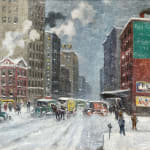

Guy C. Wiggins American, 1883-1962
When one thinks of New York City in winter it is hard to
imagine the bustling scenery of the metropolis through any other painter’s eye
that that of Guy C. Wiggins, N.A. (1883 – 1962). His wind swept images of the
streets of Manhattan, of its swaying bridges and its hustling residents trying
to survive the tunnels of wind between skyscrapers, cathedrals and great
business establishments, have become an icon of American artistic expression.
The son of noted tonalist landscape painter Carleton Wiggins and a scion of one
of the leading artistic dynasties of America, Wiggins was trained by William
Merritt Chase and Robert Henri through their associations with the Art Students
League of New York and the school of the National Academy of Design. While
Wiggins would become best know for his scenes of New York City in winter, he
would also travel throughout New England, paintings the incredible vistas,
rambling streams, and historic villages and boatyards that he happened upon. He
would become that youngest member of the Old Lyme Art Colony and respected
teacher in his own right, eventually serving as the President of the
Connecticut Academy of Fine Arts. He was the recipient of numerous prizes
during his lifetime, including ones presented by the Salmagundi Club, Art Institute
of Chicago and the Lyme Art Association.
The present work is a large and impressive painting by
Wiggins, and though it simply appears to be another of his finely crafted
scenes of New York City in winter, in fact it has a much deeper history and
significance.
“Hudson Street,” as the work is titled on its original
label from Grand Central Art Galleries, depicts one of the busy commercial
arteries of the city. Named for the great river that flanks the western border
of Manhattan, it was laid out before 1797 though not formalized until 1808,
when Trinity Church, which owned the land it sat on, ceded the property to the
city of New York. By the time Wiggins decided to depict the street circa 1932,
it was a busy place, filled up with commercial warehouses and manufactories as
well as a few remaining ancient rowhouses, already mostly forgotten, that were
quickly disappearing across the city.
It is probably no mere coincidence that Wiggins has
chosen to highlight the large commercial warehouse located at 78 Hudson Street
on the right hand side of the painting. It was home to The Paul R. Dillon
Company, as the green mural painted along its side indicates. Dillon was one of
the largest of the wholesale dealers of eggs and butter in the city, and
shipped their wares out to establishments in the greater New York and New
Jersey area of the tri-state. North of the Dillon building one can glimpse just
the edge of a hulking art deco tower, the Western Union Building – which was
completed in 1930 – not long before the painting was created.
While the scene is busy with cargo trucks taking goods
out for delivery, it is the time of the Great Depression. We still see an
occasional horse drawn cart, which still helped the poorest of businesses to
deliver their goods. Throughout the depression eggs and butter were generally
hard to obtain and both were later rationed food stuffs. Along with milk and
other staples of American life, these rationed items transformed New York City
and the rest of the country. The effect was so great, that recipes were created
so that desserts could be made without some, or all of those ingredients,
leading to the era’s famous “depression cake,” which instead used raisins,
spices and syrups to make them palatable. So, even with this enormous and
regularly packed warehouse, plenty was an illusion.
Join our mailing list
* denotes required fields
We will process the personal data you have supplied in accordance with our privacy policy (available on request). You can unsubscribe or change your preferences at any time by clicking the link in our emails.

